One Deck Galaxy How to Play Quick Links: | Objective | Setup | Your Civilization | Galaxy Deck | Influence | Playing the Game | Adversary Phase | Discover Phase | Action Phase | Results Phase | Reshuffle Galaxy Deck | Adversaries | End of Game | Two Player Game | Campaign Mode
Objective of One Deck Galaxy
The objective of One Deck Galaxy is to build up your federation in order to overcome the Adversary that is quickly approaching.
Setup for One Deck Galaxy
Create Your Civilization
- Each player chooses a Homeworld and Society Type card. Turn each card to the side matching the number of players playing the game. These two cards form the faction that each player plays as.
- Place a Federation Disc on the 2, 3, 4, and 5 spaces on the Federation Level.
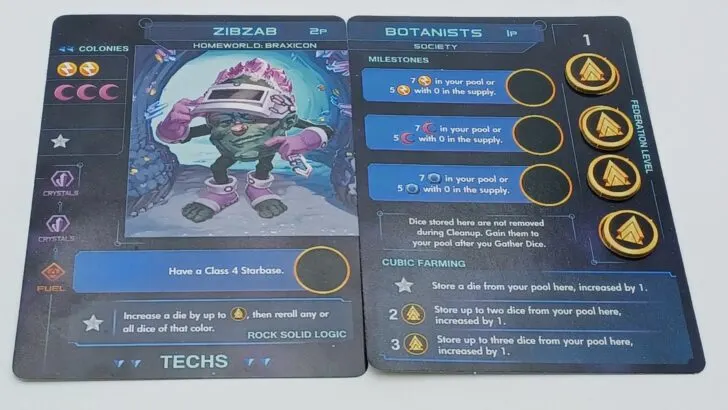
Set Up the Adversary
- Choose one of the Adversaries to face. The number of stars next to each Adversary’s name indicates how difficult it is. To make each Adversary more difficult, you can flip it to the back side.
- Place the Confrontation card that matches the Adversary to the right side of the Adversary card.
- Set the corresponding reference card near the Adversary as well.
- Place four Adversary Discs along the right side of the Adversary card.
- Shuffle the five Adversary Event cards that match the Adversary you chose. Place the cards face down on the table.

Some of the Adversaries have unique setup conditions. Check out our Adversary Guide for more details.
Creating the Galaxy Deck
- Shuffle the 40 Location and Encounter cards together.
- Once shuffled, place the cards on top of Adversary Event cards that you already placed on the table.
Setup the Starbase
- Place the Class 1 Starbase face up on the table. Set the Class 3/4 Starbase card aside for later in the game.
- Take two Influence from the Galaxy Deck and place it face down under the left edge of the Starbase card. This card will represent Fleets.
- Then take a random card, turn it face up and place it under the right edge of the Starbase card. This card will represent Science.

Create the General Supply
- Place all of the dice, discs and other materials in the middle of the table where the player(s) can reach them.
- This General Supply is limited. You can never have more dice or discs than those that are present.
Before explaining how to play One Deck Galaxy, I will explain a few topics to make the gameplay easier to follow.
Your Civilization in One Deck Galaxy
Each player in the game will control their own Civilization. Your Civilization is comprised of the Homeworld and Society card that you chose during setup. As you play the game you will expand your Civilization giving yourself access to additional Colonies and Techs.
For specifics on each Homeworld and Society card, check out our Homeworld and Society guide.
Dice and Discs
The left edge of your Homeworld card indicates the dice and discs that you receive at the start of each turn. The top three symbols represent Energy (yellow), Materials (pink), and Diplomacy (blue). You will receive a dice of the corresponding color for each symbol shown in this area. The fourth row represents Tech discs. You will receive one Tech disc for each symbol shown at the start of your turn. As you acquire Colonies you will acquire additional dice and Tech discs.

Techs
Along the bottom of your Homeworld and Society cards there is a Tech. If you pay the cost and meet the requirements, you can take these additional actions on your turn. You start with one tech on your Homeworld card and one on your Society card. As you play the game you can acquire additional Techs.

Resources
Located in the bottom row on the left side of your Homeworld card or next to a Tech, you will gain resources which can help you use your Techs or complete Milestones.

Special Rule
Located below the Milestones section on your Society card is a special rule that applies to the Society you chose. This rule is always in effect.

Milestones
Both the Homeworld and Society card have Milestones printed on them. In order to meet these Milestones you need to meet certain conditions or spend Science. When you complete a Milestone you will move a Federation disc from the right side of your Society card to the Milestone that you completed. You can complete a Milestone at any time when you meet the requirements. This raises your Federation Level.
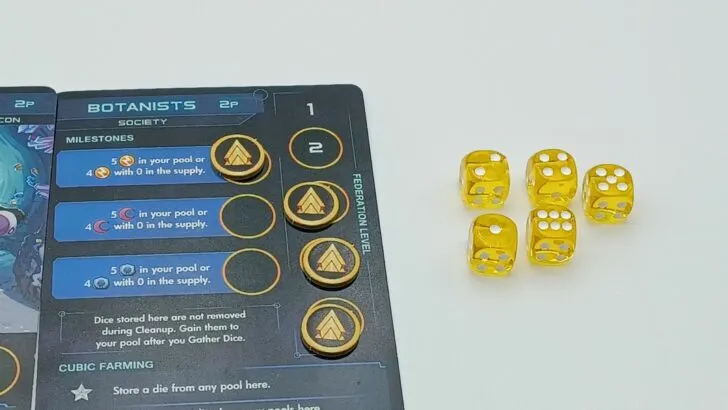
Federation Level
Finally along the right side of your Society card is your current Federation level. It will start at level one. As you complete Milestones you will remove the tokens from the right side revealing a higher Federation level. Increasing your Federation level increases the power of your Society Tech ability and allows you to confront the Adversary.

Galaxy Deck in One Deck Galaxy
The Galaxy Deck consists of 40 different cards. Each card in the Galaxy Deck is either a Location or an Encounter.
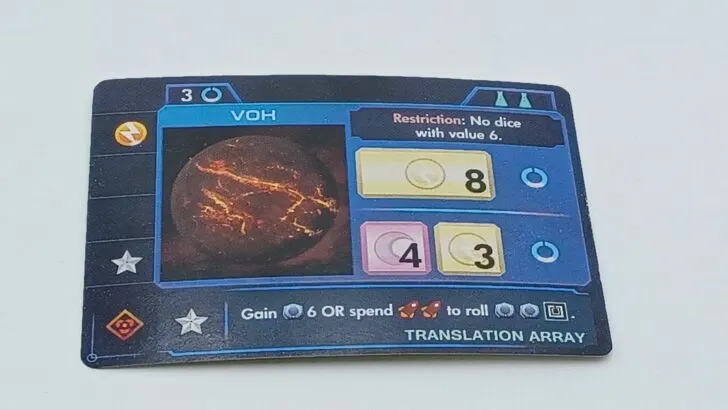
Locations
Locations are places in the galaxy that you can visit to study, develop or colonize.
The Location’s influence cost is listed above the name of the location. To claim a location you need to gain at least this much influence at the location.
To the right of the location’s name is a rule that applies to the card. You must follow this rule at all times for the location.
Below the location’s rule is the Progress Rows. To gain influence over the location you must complete these requirements. If you complete the requirements you gain the influence displayed to the right of the requirements.
Should you claim a location you can use it as either a colony (left side of card) or for tech (bottom of card).
The card’s science value is displayed in the top right corner.

Encounters
Encounters represent other forces in the galaxy. If left unchecked they can lead to problems for your Federation.
Encounters have many of the same elements as locations. The difference are as follows:
To the right of the name is the Influence Threshold. You want to keep the influence on the card below this number. If the influence on the card reaches this number, an Escalate action is triggered.
To complete an Encounter card you must complete all of the requirements listed below the Influence Threshold. You must complete all of these requirements at the same time in order to complete the Encounter.
Influence in One Deck Galaxy
Influence is one of the key mechanics in One Deck Galaxy.
The back of each card in the Galaxy Deck features symbols on the back that represents influence. Along the top of the card is the symbol for one influence while the bottom shows the symbol for two influence. When using cards to represent influence, you should use the fewest cards as possible.

Whenever a card gains influence, you will take cards from the top of the Galaxy Deck. You will keep the cards facedown and will not look at the other side of the card. To reflect different influence values you will rotate cards from the one influence to two influence side and vice versa. Whenever a card loses or spends influence, you will discard the corresponding cards to the discard pile.
Placing Influence
Throughout the game you will tuck cards under other cards to represent influence. You will use influence in a couple different ways.
At Locations you will add influence when you complete Progress Rows. To acquire a location you need to gather enough influence to meet the Influence Cost.
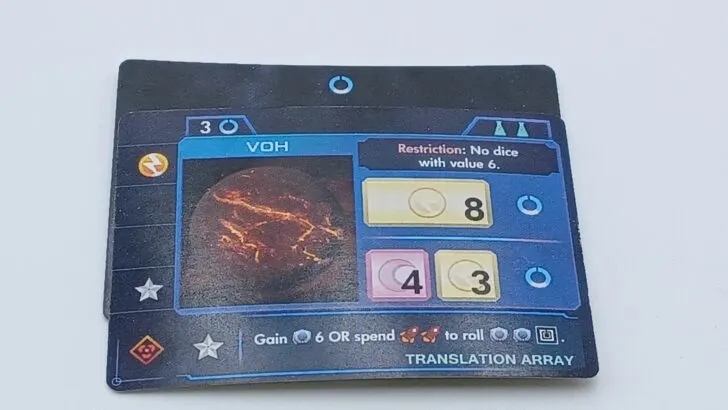
Encounters gain influence each turn that they are active during the Adversary Phase. If an encounter acquires too much influence, you will activate the Escalate effect.

Adversaries will gain influence each turn. They will gain influence based on their own unique rules. You will tuck Adversary influence underneath the top edge of the Adversary card.

As you acquire Fleets, you will place influence under the left edge of your Starbase card.

Finally you may tuck cards face-up under the right side of the Starbase card. They will represent Science.

Playing One Deck Galaxy
You will play One Deck Galaxy over a number of turns. Each turn consists of four phases. All of the players will cooperatively complete all four phases together. The four phases of each turn are as follows.
Each turn begins with the Adversary phase. This consists of resolving Adversary Events, Adversary and Encounter cards gaining influence, and time passing.
Next the Discover phase occurs. In this phase you add cards from the Galaxy Deck face up into the Discover Zone.
The next phase is the Action phase. In this phase you will roll your dice, acquire Tech and Starbase Discs, and use your dice and discs to take actions to advance your Federation and stop the Adversary.
Each turn finally ends with the Results phase. In this phase you will resolve all completed areas, and then return all dice and discs to the supply.
Adversary Phase in One Deck Galaxy
The Adversary Phase represents the passage of time with the Adversary getting closer to defeating your Federation.
Adversary Events
You will begin by looking to see if there are currently any Adversary Event cards in play. If there is an Adversary Event card in play (face down since you acquired it on the previous turn), you will flip it over and execute the effects printed on the card. Should a new Adversary Event card be revealed from the Galaxy Deck at this time, you will set it aside as it won’t be revealed until the start of the next turn.


Discard Cards
Next you will either discard one or two cards from the Galaxy Deck. The Adversary card will have an icon in the Adversary section to show you how many cards to discard. This represents the passage of time.

Adding Influence
Add one influence to the Adversary card. If there are any Encounter cards currently in play, add one influence to each active Encounter card.

Escalate
If any Encounter card reaches its Influence Threshold, you will take the corresponding Escalate action. All influence cards on the Encounter are discarded. You can then add the Encounter card to the right side of your Starbase card which adds its Science value.
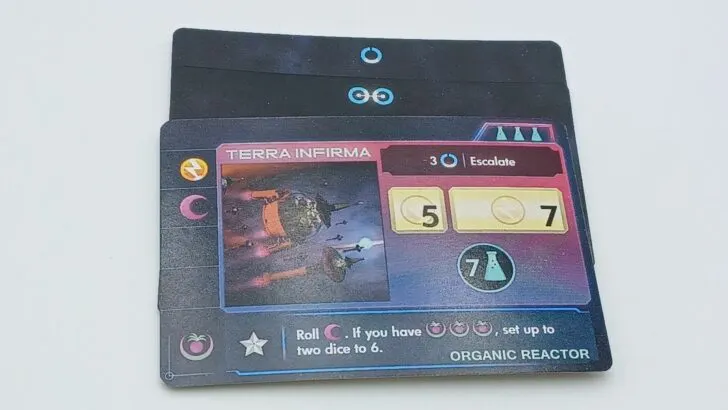
Discover Phase
To begin this phase you will look to see how many cards are currently in the Discovery Zone (face up Galaxy Deck cards). If there are less than four cards in the Discovery Zone, you will draw new cards from the Galaxy Deck until there are four cards in the area. Should there already be four cards in the Discovery Zone, you will do nothing in the Discover Phase.

Action Phase
The Action Phase has two main phases: gather and act.
Gather
To begin the Action Phase all of the players will gather the dice and Tech Discs that their civilization generates each turn. The icons along the left side of your Homeworld card indicate what dice and discs you should take. Each player takes their dice and discs from the General Supply. Players will have their own pile of dice and discs. They may not share them with the other players. If there are not enough dice or discs in the supply, you can only take what is available.

After you have acquired all of your dice, roll them.
Next check your Starbase card. There should be one or more spaces where you can place Starbase Discs. Take a corresponding number of discs from the supply and cover these spaces on the Starbase card.

Act
Once you have rolled all of your dice and gathered your discs, you need to figure out what you want to do with all of them. You can use dice and discs in a number of different ways. You can take these actions in any order, and may take the same action multiple times. If there are two players, the players can use their dice and discs in any order. Players may only use the dice and discs in their own pool though.
You must fully complete an action before you start another action.
The actions you can take at this time include:
- Placing Dice and Discs
- Calibrate Dice
- Combine Dice
- Return Dice
- Use A Tech
Place Dice and Discs
The first thing you can do is place dice and discs.
Placing Dice in Boxes
The cards have various boxes of different colors printed on them. To place a die/dice on a box, the color of the dice have to match the color of the box. Black dice (Black Ultratech) are wild and you can use them as any other color. You can cover grey boxes with dice of any color.
These boxes come in two different sizes: small and wide.
Small Boxes
Small boxes are around the size of one die. For small boxes you can only play one die whose number is equal to or higher than the number displayed on the box.

Wide Boxes
Wide boxes are around the size to two dice placed next to one another. You can place as many dice as you want on these spaces. The total of the numbers rolled on all of the dice must be at least equal to the number printed on the box. You must place all of the dice required to reach the total at the same time. Multiple players can contribute dice to complete the requirement of a wide box. You can use dice of the box’s color as well as black dice to complete the requirement.
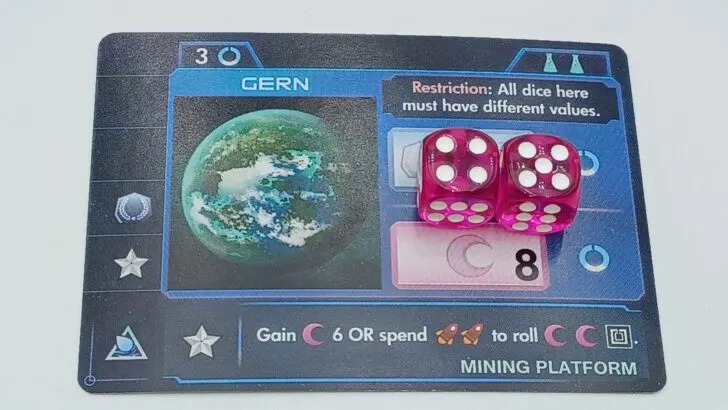
Special Boxes
Some of the boxes on the Starbase card have symbols printed on them which indicate special conditions.
A box that has the word “ANY” on it, can be filled with any one die.

Two or more linked boxes with the “=” symbol on them must have the same number placed on each space.

You can place any number of dice of any color and number on the Research Lab space.
Placing Starbase Discs
Some cards feature blue rings with a fleet or science cost inside.
To meet these requirements you need to pay the required fleet or science cost. To pay the cost you will discard/rotate an appropriate number of cards from the corresponding side of the Starbase card (fleet – left side, science – right side).
Then take one of the Starbase discs and place it on the requirement that you just paid.

Location Rules
When placing dice or discs, the location you are placing them to might have special rules. You must follow these rules at all times and they affect the entire card.

Playing Dice and Discs to the Adversary Confrontation Card
The Adversary Confrontation card has two different sides. This gives you two different ways to defeat each Adversary level. You can flip the card over at any time as long as no dice/discs are currently placed on it.
Each row on the Adversary Confrontation card corresponds to the Adversary Disc on its left. You may only try to complete the highest row that has an Adversary Disc next to it. Before you try to complete a row on the card, you should check the associated Federation Level for the row. All of the players must be at least to the Federation Level printed on that row before you can start filling in any boxes/rings in the row.

Calibrate
At the bottom of the Starbase card there are two symbols indicating how you can calibrate the dice in your dice pool. You can calibrate dice by either spending Fleets or Science.
You can spend one Fleet in order to increase or decrease the value of one die by one.
Additionally you can spend three Science in order to roll one black die. If there are two players, the players decide who gets to roll the die.
You may take either/both of these actions multiple times as long as you have enough Fleets/Science to pay the cost.
Combine Dice
In exchange for discarding two dice from your pool, you can acquire one Ultratech (black) die. You will turn the black die to the side equal to the lower valued dice that your discarded.

If there are two players, both players can discard one die to take this action. The players will decide who gets to add the black die to their pool.
Return Dice
You may choose to return one or more of your dice to the General Supply. You may choose to use this if you want to use a Tech or Combine Dice action, and there aren’t enough dice left in the General Supply.
Use A Tech
Throughout the game you will acquire a number of Techs. These allow you to take special actions on your turn.
In order to use a Tech you must place a Tech Disc on the star symbol next to the Tech. You can’t use a Tech if you don’t have any Tech Discs in your pool, or there is already a Tech Disc on the space.
Once you place the Tech Disc you will take the corresponding action.

Your Society card has a Tech printed on the bottom. At the beginning of the game you may only take the top action. Once your Federation Level reaches the corresponding level, you may instead choose to use the middle or bottom action instead of the top action.

Tech Keywords
Tech abilities use the following terms:
Gain – Take a die from the supply and add it to your pool at the value indicated on the Tech.
Roll – Take a die from the supply and roll it. You will add it to your pool as the number you rolled.
Reroll – Choose a die from your pool. Roll the die again and keep it on the number you rolled.
Increase/Decrease/Change – Choose a die from your pool. Adjust its value based on what is printed on the Tech. Then place the die back into your pool.
Exile – Take a card, die or disc and return it to the game box. It will not be used for the rest of the game.
Set – Choose a die from your pool and change it to the value specified. Then return it to your pool.
Return – Return a die/disc back to the General Supply.
Discard – Place the card in the discard pile. If you are required to discard X cards, discard the corresponding number of cards from the top of the Galaxy Deck.
Resources – As you acquire resources a Tech may become more valuable. If a resource is in brackets, count how many of that resource you currently have. Your current total for that resource is the number that applies to the bracket.
Federation Level – Some Techs get better as your Federation Level goes up. If an action has the Federation Icon in it, replace the icon with your current Federation Level.
Results Phase in One Deck Galaxy
After all of the players have finished taking actions, you will move onto the Results Phase. The Results Phase rewards you for the actions you chose to take.The Results Phase has two steps: Resolve and Reset.
Resolve
In this step you will resolve all of the dice and discs that you played in the Action Phase. You will begin with the cards in the Discover Zone. You will then handle the Starbase card, and finally deal with the Adversary Confrontation card.
Location Cards
Each Location card has two different rows on the right side. These are the two different ways that you can earn influence for the card.
If you fill in all of the boxes and rings in a row, you will acquire influence equal to the number of symbols along the right side. Add influence to the Location card equal to how much influence you earned. All dice and discs played to the Location card are returned to the General Supply.

If a Location card has enough influence on it in order to meet its Influence Cost, you will claim the card. All influence added to the card is immediately discarded.

Encounter Cards
Check each Encounter card in the Discovery Zone. If all of the boxes and rings on the card are filled, the card has been completed. One of the players will claim the card.

All of the dice and discs played to the card are returned to the General Supply. Discard all attached influence cards as well.
Claiming Location/Encounter Cards
For each Location and Encounter card you claim, you can choose to use it in one of two ways.
First you can use the card as a Colony. You will tuck the card along the left side of your Homeworld card.

Otherwise you can use it as a Tech. You will tuck the card under the bottom edge of your Homeworld card.

If there are two players, the players will choose which player will take the card. There is no limit to how many cards you can add as Colonies and Techs.
Starbase Card
After dealing with the cards in the Discovery Zone, you will move onto the Starbase card.
Adding Fleets
Look at the left side of the card. For each row you completed you will acquire Fleets. Count up the number of Fleet icons and add that much influence to the left edge of the Starbase card. Each influence counts as a Fleet.

Research Lab
Next look at the dice placed in the Research Lab. You can use as many of these dice as you want to take Study or Probe actions. You can take the Study action as many times as you want. The number of Probes you can launch depends on the current class of the Starbase.
For the Probe action you must discard a number of dice from the Research Lab equal to the number next to the ANY symbol. You will then take the top card from the Galaxy Deck. Flip the card over and slide it under the right side of the Starbase card so the Science symbols are still visible.

For the Study action you will choose a face up Location card from the Discovery Zone. Look at the card’s Science value. You will have to discard one dice from the Research Lab for each Science printed on the card that you want to take. This will be reduced by one for each influence already added to the card that you want to take. The cost cannot be reduced below zero dice. Once you discard the dice, add the Location card you choose to the right side of your Starbase card. Discard any Influence that was added to the Location card.

Upgrading Your Starbase
Finally you have the option of upgrading your Starbase. Along the top of the card is a Science cost to upgrade the Starbase. If you wish to upgrade the Starbase you will discard the corresponding amount of Science. If you have to discard cards above the cost, you receive nothing from the extra Science. You will then flip the Starbase card to the other side. If you are upgrading from Class 2 to Class 3, swap the card for the Class 3/4 card.

Adversary Confrontations
Next you will look at the Adversary Confrontation card. If you played dice/discs to the card, check to see if you filled in all of the spaces on the top row.
If you filled in all of the spaces in the top row and all of the players are the required Federation Level, remove the Adversary Disc next to the row that you completed. You will place this disc next to your Starbase card. Removing Adversary Discs increases the Adversary value for Adversary Events.

Reset
After you have completed handling the dice/discs played to the cards, it is time to reset for the next turn.
Return all dice, Tech Discs, and Starbase Discs to the General Supply unless a card specifies otherwise.
The current turn then ends. The next turn will start with the Adversary Phase.
Reshuffle the Galaxy Deck
All spent Fleet, Science, influence and other cards that are discarded during the game are added to a face up Discard Pile.
Whenever you have to draw a card from the Galaxy Deck and the next card in the stack is an Adversary Event card, set the top Adversary Event card aside. This will be slightly different for some of the Adversaries. It won’t be flipped over until the next Adversary Phase.

You will then shuffle all of the cards in the Discard Pile to form a new Galaxy Deck. Place this deck on top of the remaining Adversary Event cards.
The game then resumes where it left off.
Adversaries
Each Adversary in the game has its own unique rules which are summarized on their associated reference card. These rules may change how each phase is played.
Whenever an Encounter card or an Adversary rule results in an Escalate action, you will take the corresponding action as described on the reference card.
When an Adversary Event card is revealed, follow the instructions printed on the card immediately. Some cards may have a lasting effect. For these effects slide the card under the reference card so the additional effect can be seen.
For more details on each Adversary, see the corresponding section in our Adversaries Guide.
End of One Deck Galaxy
One Deck Galaxy can end in a number of different ways.
Should you remove the last Adversary Token from the Adversary card (revealing the “WIN” space), you immediately win the game.

If you take the last card from the Galaxy Deck triggering a reshuffle and there are no Adversary Event cards left, you become Overwhelmed. If you have any Adversary Discs next to your Starbase (acquired by completing rows on the Adversary card), you can discard one of the discs to avoid becoming Overwhelmed. You will then reshuffle the cards and continue playing the game.

If you become Overwhelmed and you have no Adversary Discs left to discard, you will lose the game.
Two Player One Deck Galaxy
You will mostly play the two player game of One Deck Galaxy in the same as the one player game with a few small tweaks.
First you will turn the Homeworld and Society cards to the 2P side.
Each player has their own personal pool for dice and discs. Your Techs cannot impact the other player’s dice or tokens unless it specifically says “from any pool”.
Both players may play dice to a wide box or Starbase row to complete it.
Each player can provide one die to create a black die. The players then have to decide who will take the black die.
When you acquire dice or tokens from anything other than Tech, the players can decide which pool to add the dice/tokens to. You may even split the dice/tokens if you acquire multiple of them.
To complete an Adversary Confrontation row, both players need to be at the required Federation Level.
You can only complete Milestones with your own pool, colonies, and techs.
If both players are Overwhelmed, you will only discard one Adversary Token to avoid defeat.

One Deck Galaxy Campaign Mode
To begin the campaign mode, choose one of the Campaign Sheets.
At the end of a game (finished against an Adversary) you will calculate your score and record it on the Campaign Sheet. You will score two points per star on the Adversary card. Additionally you will receive ten points for winning.
Should you lose a game, you will score one point per star on the Adversary card. You also score one point for each Federation Level you reach (the highest player only in a two player game). Finally you score one point for each Adversary Disc you claimed during play.
After completing a game you will cross off a combination of up to two Homeworlds, Societies, or Adversaries that you used in the game.
For each thing you crossed off, fill in the corresponding number of dotted lines that either touch the Start space or a space that you already reached. Should you reach a Jumpstart or Ability node, circle them. Their ability will be active for your next game.
Jumpstart Nodes
Before the first Gather phase in your next game, add dice for each of the Jumpstart Nodes that you have activated. You may also add Fleets to the Starbase.
Ability Nodes
Once you have activated an Ability Node, you can treat it like a Tech. To take the ability, place a Tech Disc on it. The Tech Disc placed on one of these abilities stays on the space for the rest of the current game. Therefore you can only use each of these abilities once each game.
Should an activated Ability Node not have a ring on it, its effect will always be in place.
Determining Your Success
After you have played six games, you should total the score you earned from each game. You will compare your score to the chart below to see how well you did:
- 0-39: Sprout
- 40-54: Leafling
- 55-69: Brancher
- 70-84: Shrubkin
- 85-99: Strongbark
- 100+: Legendreee

Year: 2022 | Publisher: Asmadi Games | Designer: Chris Cieslik | Artist: Alanna Cervenak, Sam “Crowbar” Henry, Robert Simmons
Genres: Card, Cooperative, Dice
Ages: 14+ | Number of Players: 1-2 players | Length of Game: 45-60 minutes
Difficulty: Moderate | Strategy: Moderate | Luck: Light-Moderate
Components: 5 Homeworld cards, 5 Societies cards, 5 Adversaries cards, 2 Starbase cards, 40 Galaxy Deck cards, 25 Adversary Event cards, 5 Adversary Confrontation cards, 5 Adversary Reference cards, 8 blue die, 8 pink dice, 8 yellow dice, 6 black dice, 12 Tech discs, 8 Federation discs, 4 Adversary discs, 4 Starbase discs, instructions
Where to Purchase: Amazon, eBay Any purchases made through these links (including other products) help keep Geeky Hobbies running. Thank you for your support.
For more board and card game how to plays/rules and reviews, check out our complete alphabetical list of board game posts.


One Deck Galaxy Adversary Homeworld and Society How to Play Guide - Geeky Hobbies
Saturday 29th of April 2023
[…] If you want a complete look at the rules for One Deck Galaxy, check out our One Deck Galaxy How to Play Guide. […]